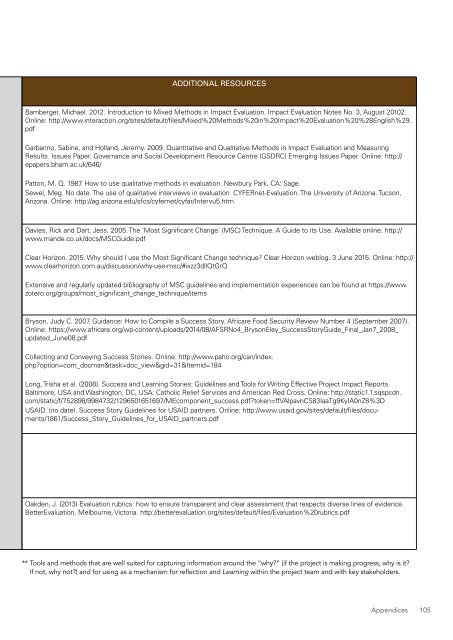DESIGNING PROJECTS IN A RAPIDLY CHANGING WORLD
srun3013fp1
srun3013fp1
Create successful ePaper yourself
Turn your PDF publications into a flip-book with our unique Google optimized e-Paper software.
ADDITIONAL RESOURCES<br />
Bamberger, Michael. 2012. Introduction to Mixed Methods in Impact Evaluation. Impact Evaluation Notes No. 3, August 20102.<br />
Online: http://www.interaction.org/sites/default/files/Mixed%20Methods%20in%20Impact%20Evaluation%20%28English%29.<br />
pdf<br />
Garbarino, Sabine, and Holland, Jeremy. 2009. Quantitative and Qualitative Methods in Impact Evaluation and Measuring<br />
Results. Issues Paper. Governance and Social Development Resource Centre (GSDRC) Emerging Issues Paper. Online: http://<br />
epapers.bham.ac.uk/646/<br />
Patton, M. Q. 1987. How to use qualitative methods in evaluation. Newbury Park, CA: Sage.<br />
Sewel, Meg. No date. The use of qualitative interviews in evaluation. CYFERnet-Evaluation. The University of Arizona. Tucson,<br />
Arizona. Online: http://ag.arizona.edu/sfcs/cyfernet/cyfar/Intervu5.htm<br />
Davies, Rick and Dart, Jess. 2005. The ‘Most Significant Change’ (MSC) Technique. A Guide to its Use. Available online: http://<br />
www.mande.co.uk/docs/MSCGuide.pdf<br />
Clear Horizon. 2015. Why should I use the Most Significant Change technique? Clear Horizon weblog. 3 June 2015. Online: http://<br />
www.clearhorizon.com.au/discussion/why-use-msc/#ixzz3dllQtGrQ<br />
Extensive and regularly updated bibliography of MSC guidelines and implementation experiences can be found at https://www.<br />
zotero.org/groups/most_significant_change_technique/items<br />
Bryson, Judy C. 2007. Guidance: How to Compile a Success Story. Africare Food Security Review Number 4 (September 2007).<br />
Online: https://www.africare.org/wp-content/uploads/2014/08/AFSRNo4_BrysonEley_SuccessStoryGuide_Final_Jan7_2008_<br />
updated_June08.pdf<br />
Collecting and Conveying Success Stories. Online: http://www.paho.org/can/index.<br />
php?option=com_docman&task=doc_view&gid=31&Itemid=184<br />
Long, Trisha et al. (2008). Success and Learning Stories: Guidelines and Tools for Writing Effective Project Impact Reports.<br />
Baltimore, USA and Washington, DC, USA: Catholic Relief Services and American Red Cross. Online: http://static1.1.sqspcdn.<br />
com/static/f/752898/9984732/1296501651697/MEcomponent_success.pdf?token=ffVAlpavnCS83IaaTg9KyIA0nZ8%3D<br />
USAID. (no date). Success Story Guidelines for USAID partners. Online: http://www.usaid.gov/sites/default/files/documents/1861/Success_Story_Guidelines_for_USAID_partners.pdf<br />
Oakden, J. (2013) Evaluation rubrics: how to ensure transparent and clear assessment that respects diverse lines of evidence.<br />
BetterEvaluation, Melbourne, Victoria. http://betterevaluation.org/sites/default/files/Evaluation%20rubrics.pdf<br />
** Tools and methods that are well suited for capturing information around the “why?” (if the project is making progress, why is it?<br />
If not, why not?) and for using as a mechanism for reflection and Learning within the project team and with key stakeholders.<br />
Appendices 105


